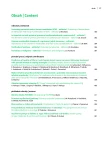-
Medical journals
- Career
Risk factors for cardiovascular diseases in the descendants of patients after early myocardial infarction
Authors: Markéta Mateřánková; Petra Karnosová; Jitka Mlíková Seidlerová; Jan Filipovský; Otto Mayer Jr
Authors‘ workplace: II. interní klinika LF UK a FN Plzeň
Published in: Vnitř Lék 2017; 63(6): 398-402
Category: Original Contributions
Overview
Goal:
The cardiovascular diseases (CVDs) developing as the result of atherosclerosis are among the most frequent causes of morbidity and mortality within the Czech Republic and elsewhere. Genetic predisposition for cardiovascular diseases is amplified in the presence of routine risk factors which can be influenced. Our aim was to establish whether the level of the risk factors for ICHS already differs in the population of healthy descendants of the patients after early myocardial infarction, as opposed to the control group of examined individuals.Methodology:
We approached adult children (n = 127; age 28.7 ± 6.5 years) of the patients with early manifestation of ICHS, who were examined within the study EUROASPIRE IV. The examination of both the descendants and the control group (n = 199; age 28.9 ± 5.3 years) focused on identifying the risk factors for ICHS.Results:
Descendants presented arterial hypertension more often (18.9 vs 8.0 %, p = 0.003) and there were more smokers among them compared to the control group (37 vs 24.1 %, p = 0.01). The levels of triglycerides (1.13 vs 0.99 mmol/l, p = 0.05) and LDL-cholesterol (2.7 vs 2.45 mmol/l, p = 0.01) were higher in the descendant group, HDL-cholesterol was similar in both groups (1.6 vs 1.67 mmol/l, p = 0.17). Increased fasting glycemia occurred more frequent in the descendant group (5.5 vs 1.5 %, p = 0.05). None of the examined participants met the criteria for the diagnosis of diabetes mellitus. Aortic stiffness was higher in the descendant group as opposed to the control group (6.2 vs 5.8 m/s, p = 0.001). The total calculated cardiovascular risk based on the SCORE system was also higher in the descendant group as compared to the control group – the current risk related to the age of 40 years: 0.35 (0.19–0.64) vs 0.20 (0.13–0.47), p < 0.0001 and the risk related to the age of 60 years: 3.35 (2.23–5.36) vs 2.40 (1.58–4.11), p < 0.0001.Conclusion:
The population of the descendants includes, based on our results, a greater number of smokers and hypertensive patients. They also have higher levels of LDL-cholesterol, triglycerides and impaired fasting glycemia more frequently. Unfavourable genetic predisposition along with unfitting lifestyle contributes to a higher likelihood of accumulation of risk factors, and therefore to a higher risk of a cardiovascular disease manifestation. In practice we should try, with regard to these predisposed individuals, to lower their cardiovascular risk and implement a healthy lifestyle.Key words:
atherosclerosis – cardiovascular disease – lifestyle – myocardial infarction – primary prevention – risk factors for CVD
Sources
1. Cífková R. Epidemiologie kardiovaskulárních onemocnění. Postgraduální medicína – mimořádná příloha 2012; 4 : 6–13.
2. Cífková R, Vaverková H, Filipovský J et al. Summary of the European Guidelines on cardiovascular disease prevention in clinical practice (version 2012): Prepared by the Czech Society of Cardiology. Cor et Vasa 2014; 56: e168-e188. Dostupné z WWW: <http://www.e-coretvasa.cz/casopis/view?id=5580>.
3. European Society of Cardiology. Clinical Practice Guidelines (online) [2014–10–28]. Dostupné z WWW: <http://www.escardio.org/guidelines-surveys/esc-guidelines-surveys/esc-guidelines/Pages/GuidelinesList.aspx>.
4. Eckel R, Jakicic J, Ard J et al. 2013 AHA/ACC guideline on Lifestyle Management to Reduce Cardiovascular Risk. Circulation 2014; 129(25 Suppl 2): S76-S99. Dostupné z DOI: <http://dx.doi.org/10.1161/01.cir.0000437740.48606.d1>. Erratum in Circulation 2014; 129(25 Suppl 2): S100-S101. Circulation 2015; 131(4): e326.
5. Conroy R, Pyörälä K, Fitzgerald A et al. [SCORE project group]. Estimation of ten-year risk of fatal cardiovascular disease in Europe: the SCORE project. Eur Heart J 2003; 24(11): 987–1003.
6. Filipovský J Predictive value of central blood pressure and arterial stiffness for cardiovascular events. In: Laurent S, Cockroft J. Central aortic blood pressure. Masson: Paris 2015 : 61–68. ISBN 978–2842999438.
7. Kestilä P, Magnussen CG, Viikari JS et al. Socioeconomic status, cardiovascular risk factors, and subclinical atherosclerosis in young adults: the cardiovascular risk in Young Finns Study. Arterioscler Thromb Vasc Biol 2012; 32(3): 815–821. Dostupné z DOI: <http://dx.doi.org/10.1161/ATVBAHA.111.241182>.
8. Šimon J. Úloha konvenčních a nekonvenčních rizikových faktorů v prevenci a léčebné intervenci kardiovaskulárních chorob. Postgraduální medicína 2007; 9(4): 361–365.
9. Nussbaumerová B. Co je nového v prevenci kardiovaskulárních onemocnění? Medicína po promoci 2016; 17(3): 210–217.
10. Vráblík M, Freiberger T, Lánská V et al. Projekt Atractiv: Zlepšení kardiovaskulární prevence v podmínkách primární péče v České republice. Vnitř Lék 2008; 54(12): 1131–1139.
11. Tsao C, Vasan R. Cohort Profile: The Framingham Heart Study (FHS): overview of milestones in cardiovascular epidemiology. Int J Epidemiol 2015; 44(6): 1800–1813. Dostupné z DOI: <http://dx.doi.org/10.1093/ije/dyv337>.
Labels
Diabetology Endocrinology Internal medicine
Article was published inInternal Medicine

2017 Issue 6-
All articles in this issue
- Risk factors for cardiovascular diseases in the descendants of patients after early myocardial infarction
- “Snags” connected with establishing the vitamin D
- Clinical study FOURIER
- Primary testicular lymphoma
- Rivaroxaban in high-risk patients
- Two perspectives on venous thromboembolism in oncology
- Insulin pump in type 2 diabetes: B-cell focused treatment
- Predictors of quality of life in Czech female breast cancer survivors following treatment with special interest to coping strategies
- Internal Medicine
- Journal archive
- Current issue
- Online only
- About the journal
Most read in this issue- Primary testicular lymphoma
- Insulin pump in type 2 diabetes: B-cell focused treatment
- “Snags” connected with establishing the vitamin D
- Two perspectives on venous thromboembolism in oncology
Login#ADS_BOTTOM_SCRIPTS#Forgotten passwordEnter the email address that you registered with. We will send you instructions on how to set a new password.
- Career

